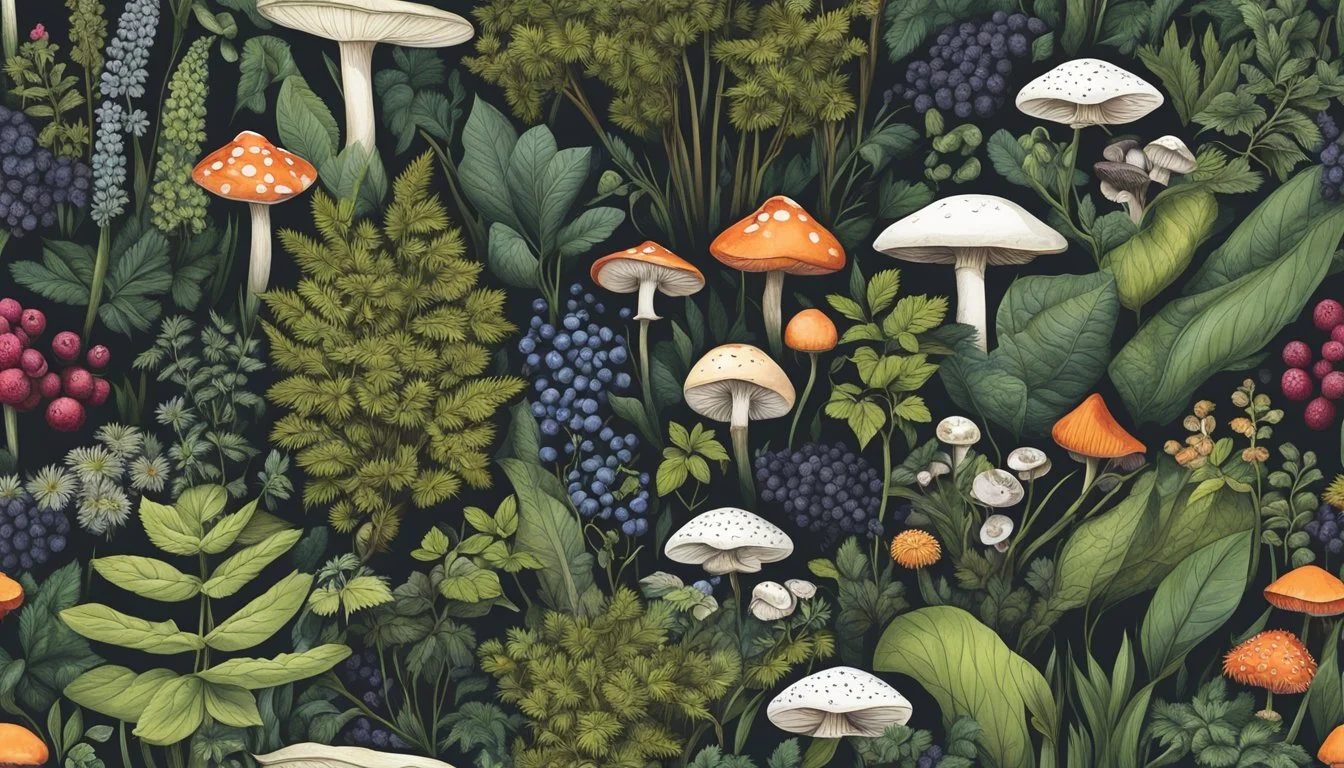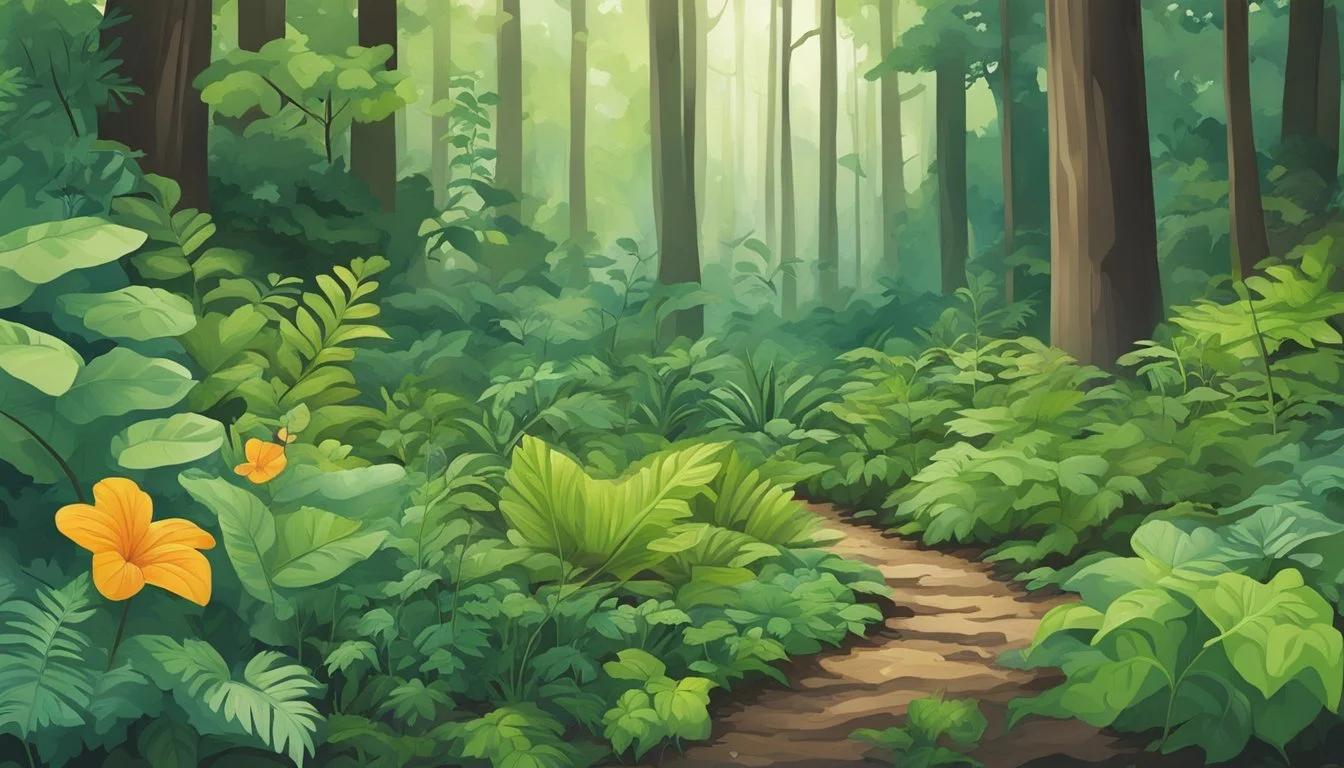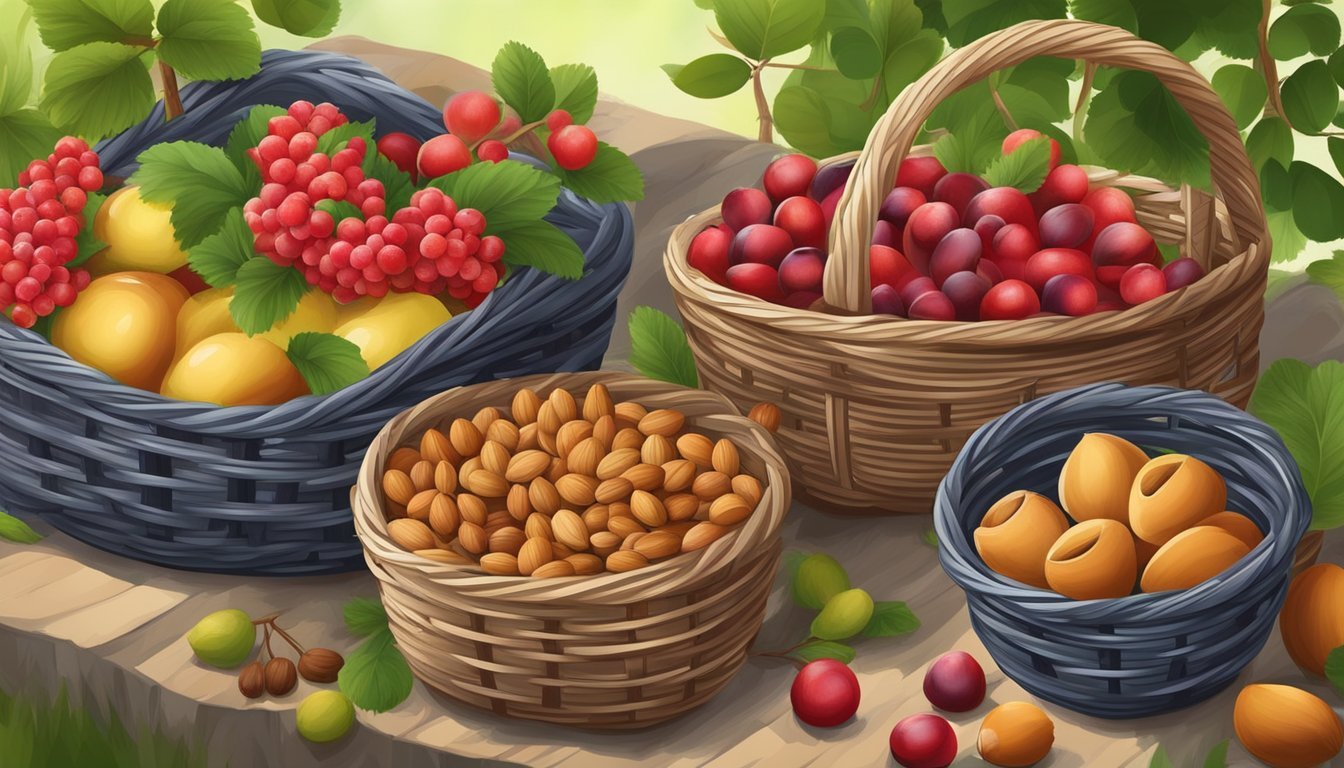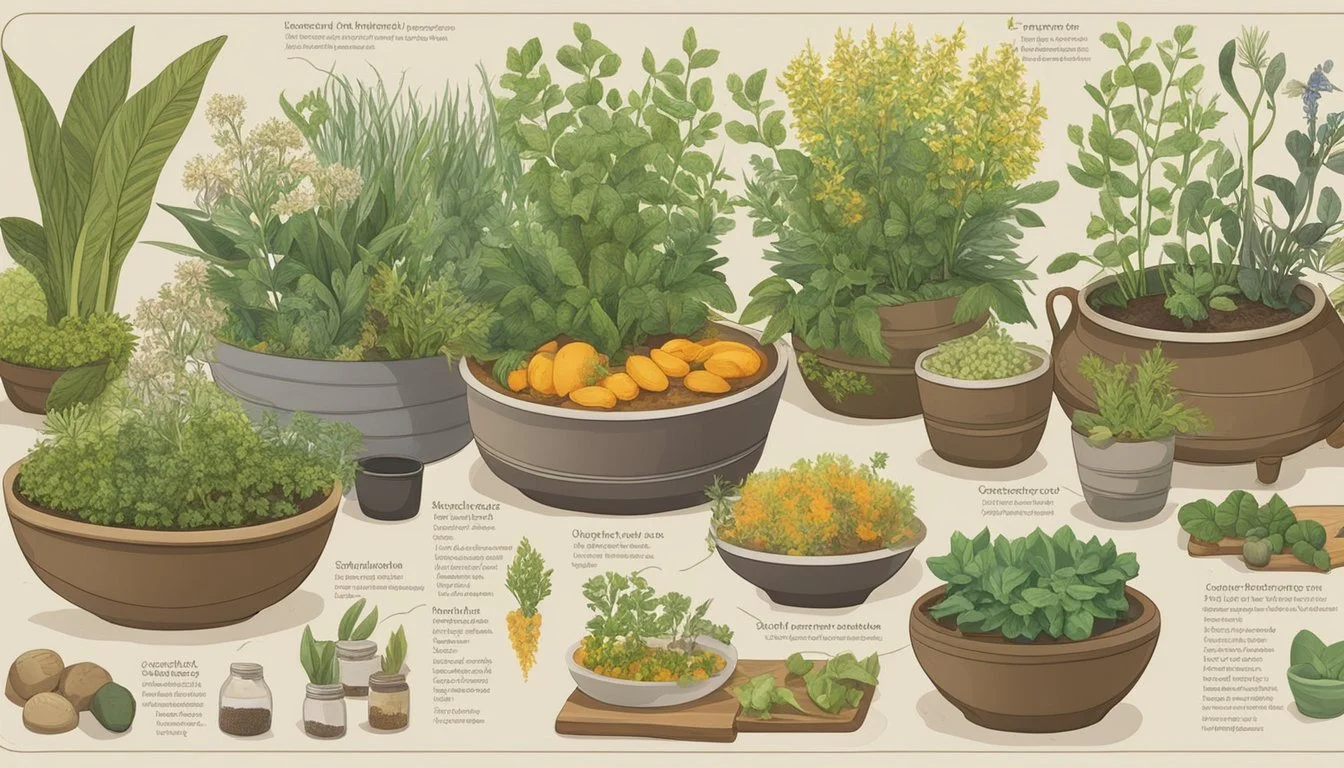Black Belt Native Edible Plants
A Guide to Sustainable Foraging
The Black Belt region is rich with native edible plants that have been utilized by Indigenous Peoples for centuries. These plants not only provide nutritional value but also play a significant role in the ecosystem. Understanding these plants and their uses can offer valuable insights into sustainable living and the importance of preserving native species.
Black oak is particularly cherished in certain areas for its acorns, which can be processed into nutritious flour. Manzanita berries are another staple, offering a unique flavor and versatility in various culinary applications. The region's diverse flora includes species like wild mint and wild rose, which have both medicinal and culinary uses, contributing to the health and well-being of those who partake.
The Black Belt's ecosystem, with its unique combination of soil and climate, supports a wide range of native edible plants. These plants not only sustain human life but also provide habitats and food for local wildlife, creating a balanced and thriving environment. As interest in indigenous foods grows, so does the appreciation for these remarkable plants and the traditional knowledge that surrounds them.
Understanding Native Edible Plants
Native edible plants offer a window into the region's rich history, ecological significance, and nutritional value. They play a crucial role in the diets of indigenous peoples and provide sustainable options for modern consumption.
Historical Significance
Native plants have been an essential part of the diet and culture of indigenous peoples for centuries. For example, fruit from pawpaw trees and nuts from native oaks provided vital nutrients and were often used in traditional recipes. Indigenous communities have cultivated and consumed these plants, passing down knowledge through generations.
Prickly Pear Cactus and American cranberries are other examples. The prickly pear's pads and fruit were significant in the diets of Native Americans, and cranberry shrubs were utilized for their medicinal properties as well as their tart fruit.
Understanding these plants' historical uses highlights the deep relationship between people and their environment. This connection is vital for preserving cultural heritage and fostering appreciation for native biodiversity.
Ecological Benefits
Native plants play an indispensable role in sustaining local ecosystems. They support thousands of insect species, which, in turn, feed birds and other wildlife. For example, the evergreen leaves and branching stems of American cranberry plants provide a habitat for various insects and small animals.
These plants are often more resilient to local pests and diseases, reducing the need for chemical interventions. Their deep root systems help prevent soil erosion and improve soil health. By planting native edibles, individuals contribute to a healthier ecosystem, promoting biodiversity and ecological balance.
Native edible plants also require less water and maintenance than non-native species, making them ideal for sustainable gardening practices. This ecological harmony underscores the importance of integrating these plants into cultivation and conservation efforts.
Nutritional Value
Native edible plants are nutritional powerhouses. They provide essential vitamins, minerals, and antioxidants that can enhance diets. For example, the prickly pear cactus boasts high levels of vitamin C, magnesium, and fiber. Likewise, pawpaw fruit is rich in vitamins A and C, providing necessary nutrients for a balanced diet.
American cranberries are another excellent example, containing high levels of antioxidants and vitamins, promoting cardiovascular health and reducing inflammation. These plants were not only sustenance for indigenous peoples but also offer significant nutritional benefits that are often labeled as "superfoods" in modern diets.
Incorporating native plants into diets can lead to a healthier and more diverse nutritional intake, emphasizing their value beyond cultural and ecological aspects.
The nutritional benefits of these plants make them an important addition to contemporary food practices, aligning health with sustainability.
Choosing the Right Plants for Your Garden
To successfully grow native edible plants, it is crucial to consider soil composition, sunlight exposure, climate adaptation, and water requirements. These factors ensure that plants thrive in their environment, providing a sustainable and productive garden.
Soil and Sunlight Requirements
Selecting native edible plants suited to your garden's soil type and sunlight exposure is essential. Many native edibles, like American cranberry, require specific soil conditions. Cranberries demand acidic soils with a pH of 4.0 to 5.2.
Full sun exposure is vital for many plants like spinach and chard to ensure healthy growth. Conversely, plants such as the American hop-hornbeam can tolerate partial shade. Evaluating the soil and sunlight in your garden helps you choose plants that will flourish.
Plant Hardiness and Adaptation
Understanding plant hardiness zones and the ability of plants to adapt to local conditions is key. For instance, the American hop-hornbeam thrives in hardiness zones 3-9, making it suitable for a wide range of climates.
Choosing native plants adapted to local conditions reduces the need for fertilizers and pesticides. Plants well-suited to your region are more resistant to pests and diseases. Garlic mustard and bee balm are examples of plants that have adapted well to various environmental conditions.
Water and Soil Moisture Tolerance
Watering needs vary significantly among native edible plants. For example, American cranberries require consistently moist soil. They thrive in sunny, acidic bogs where root moisture is constant.
Other plants, like certain herbs, prefer well-drained soil and can tolerate dry conditions. Rosemary and thyme, for instance, are drought-tolerant herbs that thrive in dry soil. Understanding the water requirements and soil moisture tolerance of each plant ensures that you provide the right conditions for optimal growth.
Major Species Profiles
Black Belt Native Edible Plants encompass a variety of important species, each offering unique benefits and characteristics. This section covers significant species in detail, focusing on trees and shrubs, berries and fruits, as well as herbs and flowers.
Trees and Shrubs
Native to the Black Belt region, the Texas Persimmon (Diospyros texana) is a prominent fruit-bearing tree. Its small, black fruit is rich in flavor and provides an excellent source of vitamin C and fiber.
Another tree to note is the Mexican Plum (Prunus mexicana), which produces tart, edible plums. This tree is beneficial for wildlife and can be used in jams and jellies.
American Hazelnut (Corylus americana) is a shrub valued for its edible nuts. This species supports wildlife while offering a nutritious food source for humans.
Berries and Fruits
The Blackberry (Rubus fruticosus) thrives in the Black Belt, producing sweet, juicy berries. These can be eaten fresh or used in various culinary applications such as pies and preserves.
Blueberries (Vaccinium spp.) are another essential fruit, known for their high antioxidant content. Particularly, the Rabbit-Eye Blueberry (Vaccinium virgatum) is well-suited to the region's climate.
Dewberries (Rubus spp.) grow wild and yield fruits similar to blackberries. They are enjoyed raw, in desserts, or made into jams, contributing both flavor and nutrition.
Herbs and Flowers
The Common Violet (Viola sororia), often overlooked, provides edible flowers and leaves. These can be added to salads or used as garnishes, offering a mild, sweet flavor.
Wild Garlic (Allium vineale) adds a burst of flavor to dishes with its robust, garlicky taste. Its bulbs and stems are used in culinary preparations, making it a versatile ingredient.
Finally, the Camas Lily (Camassia spp.) produces beautiful flowers and edible bulbs. Once a staple of Native American diets, these bulbs can be roasted or boiled to provide a starchy food source.
Cultivation and Care
Proper cultivation and care are crucial for the successful growth of native edible plants in the Black Belt region. These practices include strategic planting, regular maintenance, and effective pest and disease management.
Planting Strategies
When planting native edible plants, soil preparation is essential. Ensure the soil is well-aerated, fertile, and has the appropriate pH level for the specific plant species. For example, cranberries require acidic soil with a pH between 4.0 and 5.2.
Timing is also important. Planting should generally occur in mid to late spring to avoid the risk of frost damage. Utilize raised beds or container gardening if soil conditions are not optimal. Correct spacing is needed to prevent overcrowding, which can lead to poor air circulation and increased disease risk.
Maintenance and Pruning
Regular maintenance tasks include watering, mulching, and fertilizing. Native plants often require consistent moisture, particularly during dry periods. Mulching helps retain soil moisture and suppress weeds.
Pruning should be done periodically to remove dead or diseased branches and promote healthy growth. The frequency and extent of pruning depend on the plant species. For example, American black currant bushes should be pruned to maintain their shape and encourage fruit production.
Pest and Disease Management
Effective management of pests and diseases begins with monitoring plants regularly. Common pests in the Black Belt region include aphids, caterpillars, and beetles. Employ organic pesticides or introduce beneficial insects like ladybugs to control these pests naturally.
Diseases such as powdery mildew and root rot can affect native edible plants. To mitigate these, ensure proper spacing for air circulation and avoid over-watering. If an infection is detected, remove and destroy affected plant parts promptly to prevent spread.
Row plantings can be considered to provide effective pest and disease control through natural barriers. Implementing these strategies will help ensure the healthy growth and productivity of native edible plants.
Harvesting and Storage
Foraging for native edible plants in the Black Belt region requires knowledge of the optimal harvest seasons and effective storage methods to ensure the quality and longevity of the gathered produce. Preservation techniques like drying, fermenting, and freezing help maintain the freshness and nutritional value.
Optimal Harvest Seasons
Understanding the harvest seasons is crucial for collecting plants at their peak flavor and nutritional value. In May, tender shoots and greens such as dandelions and wild leeks can be gathered. June brings an abundance of berries, including blackberries and dewberries, ideal for fresh consumption or creating jams, jellies, and syrups.
In July, wild fruits like persimmons and elderberries mature. Foraging mushrooms like chanterelles and morels is also productive from spring through early summer. Proper timing enhances the quality of foraged food, ensuring maximum flavor and nutritional benefits.
Preservation Techniques
To extend the shelf life of foraged edibles, preservation techniques like drying, fermenting, and freezing are essential. Drying is suitable for herbs, nuts, and mushrooms, keeping them usable for months. Fermenting works well for sauerkrauts and pickled vegetables, enhancing both shelf life and flavor complexity.
Freezing retains the texture and nutritional value of berries and leafy greens. Blanching before freezing preserves color and texture. Techniques like making syrups, jams, and jellies from fruits also ensure extended storage while maintaining the plants' essence and nutritional value.
Maximizing Shelf Life
Proper storage techniques are critical to maximizing the shelf life of harvested native plants. Cool, dark, and dry environments, such as pantries for nuts and dried herbs, prevent spoilage. Airtight containers and vacuum sealing can further extend freshness by reducing exposure to air and moisture.
When freezing, it's important to use freezer-safe bags or containers to prevent freezer burn. Labeling items with the harvest date helps manage inventory and use older items first, ensuring nothing goes to waste. For fermented items, storing in a refrigerator extends their edibility while maintaining beneficial probiotics.
Benefits for Wildlife and Pollinators
Using native edible plants in gardening supports various forms of wildlife and ensures the health and longevity of local ecosystems. It provides a foundation for pollinators and birds to thrive, which is crucial for the balance of natural habitats.
Attracting Beneficial Insects
Native plants are highly effective in attracting beneficial insects like bees, butterflies, and ants. These species have adapted to local plants over time, ensuring they can efficiently collect nectar and pollen. For example, species such as the American cranberry thrive in native habitats and supply a rich source of food for bees. This relationship enhances pollination rates and boosts crop yields.
The diversity of native plants also invites a wider range of pollinators. Butterflies, in particular, are drawn to the specific scents and colors found in native flora. The compatibility between native plants and local insects enhances the survival rate of these pollinators. Moreover, native plants generally require less maintenance, as they are well-suited to the local soil and climate conditions, making them a sustainable choice for long-term gardening.
Providing Habitats for Birds
Native plants also play a crucial role in providing habitats for birds. These plants offer the necessary food, shelter, and nesting materials that local bird species need to survive. For instance, the dense foliage of native shrubs provides cover for birds from predators and harsh weather. Birds such as hummingbirds feed on the nectar of flowering plants like borage, a native species with bright blue or pink flowers.
The co-evolution of birds and native plants over thousands of years has created a mutual dependency. Birds help with seed dispersion, ensuring the continuous growth of these plants, while the plants provide essential resources for the birds. This symbiotic relationship highlights the importance of native plants in maintaining healthy bird populations.
By integrating native edible plants into gardens, one can create a supportive environment for both insects and birds. This not only enriches the local biodiversity but also promotes a balanced and thriving ecosystem.
Edible Landscaping Tips
Creating an edible landscape involves harmonizing beauty and utility. By thoughtfully considering design and integrating edible plants with ornamental ones, a garden can achieve both aesthetic appeal and bountiful harvests.
Design Considerations
Effective edible landscaping starts with a solid design plan. One crucial aspect is the garden layout. Arranging plants based on their sunlight and water needs ensures healthy growth. For instance, placing sun-loving plants like tomatoes in areas that receive full sun maximizes their productivity.
Another important consideration is soil quality. Testing the soil's pH and nutrient levels helps determine what amendments are necessary for optimal plant health. Amending the soil with compost can improve fertility, ensuring that both edible and ornamental plants thrive.
Pathways are essential for accessibility and maintenance. Utilizing materials like gravel or wood chips for pathways can keep the garden organized and prevent soil compaction near plant roots. Soft, accessible pathways also add visual structure to the garden layout, enhancing its overall appearance.
Watering systems should be efficient and sustainable. Drip irrigation and rain barrels are excellent methods to provide consistent moisture without wasting water. Consistent watering benefits the entire garden ecosystem, especially for plants like cranberries which require constant root moisture.
Integrating Edible Plants with Ornamentals
Blending edible plants with ornamental ones creates a garden that is both functional and attractive. Companion planting is a valuable technique where plants that benefit each other’s growth are paired together. For example, pairing marigolds with vegetables can deter pests and add vibrant flowers to the landscape.
Creativity in arrangement can transform traditional garden spaces. Edible plants like kale, which has striking foliage, can be interspersed with ornamental flowers to create visual interest. Vertical gardening techniques, such as using trellises for climbing plants like beans, also save space while adding height and structure.
Selecting dual-purpose plants enhances both beauty and utility. Yaupon Holly offers both ornamental value and medicinal uses. Its leaves can be used to make tea, combining function with aesthetics.
Lastly, multi-layer planting, or creating edible forests, involves layering different plant species. Trees, shrubs, and groundcovers are selected to form a diverse, productive ecosystem. This approach mimics natural forests, improving biodiversity and sustainability within the garden.
Culinary Uses of Native Plants
Native plants offer unique flavors and nutritional benefits, making them valuable for both traditional and modern culinary use. They have been integral to the diets of indigenous peoples for centuries and continue to be incorporated into contemporary cooking for their health benefits and distinctive tastes.
Traditional Recipes and Preparations
Native plants have a storied place in traditional recipes, having been used by indigenous communities for centuries. Trailing Blackberry (Rubus ursinus) is a prime example. Often consumed fresh or dried, its sweet berries are made into preserves or eaten as is, providing a natural source of sugar and vitamins.
Another plant, the Tall Oregon Grape (Mahonia aquifolium), is known for its tart berries which are traditionally used in jellies and wines. Their high vitamin C content made them a valuable resource.
Hooker Onion (Allium acuminatum) is another native plant, used for its mildly spicy flavor in traditional dishes. Alongside these, Sage (Salvia officinalis) has been utilized not only for its aromatic leaves but also for medicinal teas that are believed to offer digestive benefits. These plants were often central to seasonal diets, offering both sustenance and medicinal benefits.
Modern Cooking and Nutrition
In modern cooking, native plants are celebrated for their nutritional profiles and unique flavors. Dandelion leaves, once considered just weeds, are now appreciated for their bitter, earthy taste and vitamin richness. They are often added to salads or cooked as greens, providing a substantial dose of vitamins A and C.
Salmonberry (Rubus spectabilis), another native berry, features in modern recipes like compotes and dessert sauces. Its vibrant color and sweet-tart flavor make it a popular choice for creating visually appealing dishes.
American Cranberry, used traditionally for its tart flavor and high pectin content, continues to be a favorite in sauces, juices, and even protein bars. Its health benefits, including antioxidants, make it a staple in many diets.
Blackberry wine has also gained popularity, offering a naturally sweet and complex flavor profile perfect for gourmet cooking or casual dining. These contemporary applications highlight the versatility and enduring appeal of native plants.
Conservation and Ethical Foraging
Foraging native edible plants in the Black Belt region demands a balance between enjoying nature’s bounty and preserving the ecosystem. Essential practices ensure sustainable harvesting and support local environments.
Sustainable Foraging Practices
Sustainable foraging starts with respecting nature. Foragers should avoid overharvesting by taking only what they need and leaving plenty behind for wildlife and others. This ensures plant populations remain robust.
Ethical considerations include gaining permission before foraging on private property and adhering to local regulations. Foragers must avoid trampling vegetation and disrupting habitats.
Minimizing impact also involves foraging in small groups to reduce ecosystem disturbance. Carrying a field guide can help identify plants accurately and avoid harvesting endangered species. For sustainable foraging, rotate foraging locations to prevent overuse of a particular area.
Supporting Local Ecosystems
Supporting local ecosystems means understanding the role of each plant in its environment. Native plants often have critical relationships with local wildlife, providing food and shelter.
Foragers can support conservation efforts by participating in or donating to local environmental groups. These organizations work to preserve natural habitats and educate the public about sustainable practices.
Furthermore, foragers can plant native species in their gardens to bolster local biodiversity. This helps create urban refuges for wildlife and maintains genetic diversity of native plants. Monitoring the health of foraging sites and reporting any ecological changes to conservation groups can aid in broader environmental protection efforts.











